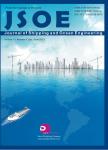Atlas-B: Development and Testing of a Brazilian Deep-Ocean Moored Buoy for Climate Research
Atlas-B: Development and Testing of a Brazilian Deep-Ocean Moored Buoy for Climate Research作者机构:Laboratory for Modeling and Observation of the Ocean Institute of Oceanography University of Sao Paulo Sao Paulo05508-120 Brazil Naval Hydrographical Service and University of Buenos Aires Buenos Aires C12 70ABV Argentina IPqM (Research Institute of the Brazilian Navy) Rio de Janeiro 21931-095 Brazil RDSea International St. Pete Beach Florida 33706 USA INPE (National Institute for Space Research) CPTEC (Center for Climate Research and Weather Prediction) Cachoeira Paulista12630-000 Brazil MCTI(Brazilian Ministery for Science Technology and Innovation) Brasilia 70067-900 Brazil
出 版 物:《Journal of Shipping and Ocean Engineering》 (船舶与海洋工程(英文版))
年 卷 期:2014年第4卷第5期
页 面:140-151页
学科分类:0821[工学-纺织科学与工程] 08[工学] 0816[工学-测绘科学与技术] 082101[工学-纺织工程]
主 题:Atlas-B Buoy PIRATA Southwest Atlantic hurricane Catarina SACZ.
摘 要:The PIRATA-SWE (Prediction and Research Moored Array in the Tropical Atlantic-Southwest Extension) was conceived in the early 2000s to gather observations necessary to improve the understanding of the variability of ocean-atmosphere interactions in the SACZ (South Atlantic Convergence Zone), which are believed to influence South American climate. To properly monitor the SACZ, the preliminary design for the PIRATA-SWE array considered the mooring of four buoys, with the southernmost one in the sub-tropics. In 2005, three buoys were deployed in the tropical region. Four years later, in 2009, efforts were started to assemble and deploy a Brazilian prototype of the TAO/PIRATA Atlas (autonomous temperature line acquisition system) buoy-the Atlas-B. Finally, in April 2013 the first Atlas-B, nicknamed "Guariroba", was moored for a testing period at 28.5° S, 44° W, which is the site originally planned for the fourth PIRATA-SWE buoy. In early November 2013, after being detected adrift, the buoy with the upper 700 m part of the mooring line was rescued in an emergency operation. In June 2014, the bottom part was successfully recovered. A new deployment is planned for late 2014. This paper describes part of the learning process of adapting and building the Atlas-B buoy and presents a brief discussion of the data collected during the pilot deployment.



